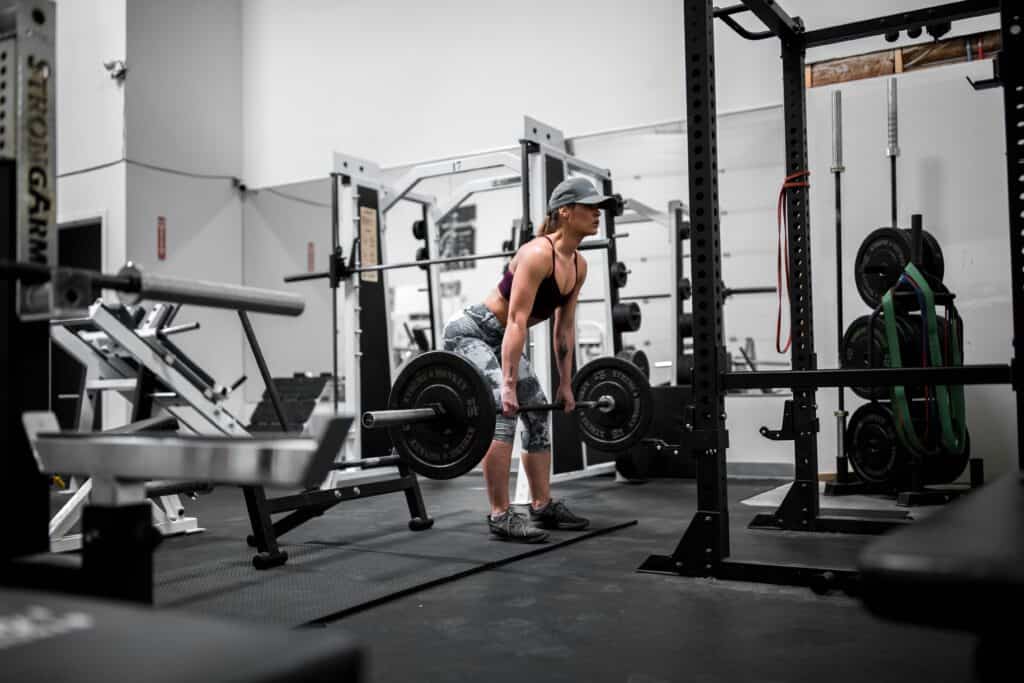There are various forms of the deadlift exercises that one can do to help build overall strength and power. The stiff-leg deadlift (SLDL) and Romanian deadlift (RDL), are two such examples. Both exercises can be done using either a barbell, dumbbell or kettlebells. Stiff-leg deadlifts and Romanian deadlifts are also effective exercises for targeting the posterior chain, including the hamstrings, glutes, and lower back.
This article will look at the barbell versions of each. The two movements look pretty much similar if you were to see them performed side-by-side. Both exercises stress the hamstring group more than a traditional deadlift exercise. There are some the key differences.
Differences Between Deadlifts (RDL & SLDL)
The SLDL and RDL are often considered the same exercise, but you need to understand some of the nuances between them. The main difference between each exercise is the amount of flexion that occurs in the knees. For example, in the SLDL, the knees start fully extended before unlocking slightly as part of the forward hinge. In the case of the RDL, the knees remain bent while executing the movement. When you perform an RDL, your hips are pushed back to the rear, providing greater hip joint rotation. When your hips flex more, the glutes end up doing more of the work.
Both exercises basically work the same muscles (glutes, hamstrings and back). However, the SLDL, using a more neutral spine ends up getting more lower back activation. A few areas where some people may run into trouble are with exercise technique and if they lack strength and mobility. Let’s take a look at each type of deadlift and discuss each of them.
Romanian Deadlift
With the RDL, the knees are bent more, as mentioned above, compared to a SLDL. This in turn, provides greater hip activation and flexion. Keep in mind, many experts believe that locking the knees out completely can increase the chance of injury when performing any type of deadlift.
In terms of technique, position the feet shoulder-width apart while holding the bar with an overhand grip (aka a clean grip). Next, set your back tightly in a complete arch. We’re talking about lumbar extension here. This is real important. I would first suggest to practice the movement near a wall. Stand about a foot away from the wall as a starting position using only bodyweight. Perform a (partial) RDL movement until the glutes come in contact with the wall. Work on maintaining that slight lumbar extension I mentioned above. Then move a few more inches away from the wall and repeat. Continue to move forward, going deeper into the exercise, each time, until you find your end limit. When you feel comfortable with the technique, try the same thing with a broom stick or dowel. Eventually progress to an Olympic bar with no weight, followed by a loaded bar.
How to Perform the Movement
To perform an RDL properly, lower the weight to a comfortable position just below the knee, this in turn, engages the hamstring fully. Keep the knees “relaxed” and slightly bent (about 20-30 degrees). Move the hips back to execute the movement before driving the hips forward as you stand back up with the weight.
The goal is to hinge at the hips as far as you can without losing the arch in your back. Strength and mobility dictates the range of motion someone ends up typically using. Unlock the knees as you hinge, allowing the knees to remain slightly bent until you return to standing vertically, straightening them as you straighten the hips. Keep the bar as close to the legs as possible throughout the motion. The RDL is a great exercise for developing strength through the posterior chain.
Stiff Leg Deadlift
The SLDL is similar to a regular deadlift but differs because you keep your legs “almost” straight throughout the workout. The SLDL is considered more of a low back exercise and is typically done last in most leg routines. SLDL’s may place slightly more emphasis on the lower back due to the greater range of motion and hip movement.
The foot position can vary slightly between the two exercises based on personal preference and comfort. However, generally, in both exercises, the feet are placed around hip-width apart or slightly wider, and the weight is distributed evenly throughout the feet. Stay strong!
Jefit: The Best App for Building Strength, Power, and Muscle
If you’re serious about building muscle, increasing strength, and developing explosive power, the Jefit strength training app is your ultimate training companion. With over 20 million downloads and 12+ million active users, Jefit is one of the world’s most trusted workout tracking apps. Named the Best Fitness App of 2024 and featured in Men’s Health, PC Magazine, and USA TODAY, Jefit offers expertly designed workout programs, detailed gym performance tracking, and a supportive fitness community to keep you motivated. Whether you want to follow a scientifically proven power training plan, track your progress in real time, or optimize training intensity for faster results, Jefit gives you all the tools you need — in one powerful app. Download Jefit today on iOS and Android to start building strength and power with precision.
- Fibermaxxing: Viral Nutrition Trend You Should Know - December 17, 2025
- Hybrid Metabolic Strength Training for Faster Results - December 10, 2025
- Why Lifters Choose JEFIT App for Real Strength Gains - December 3, 2025
